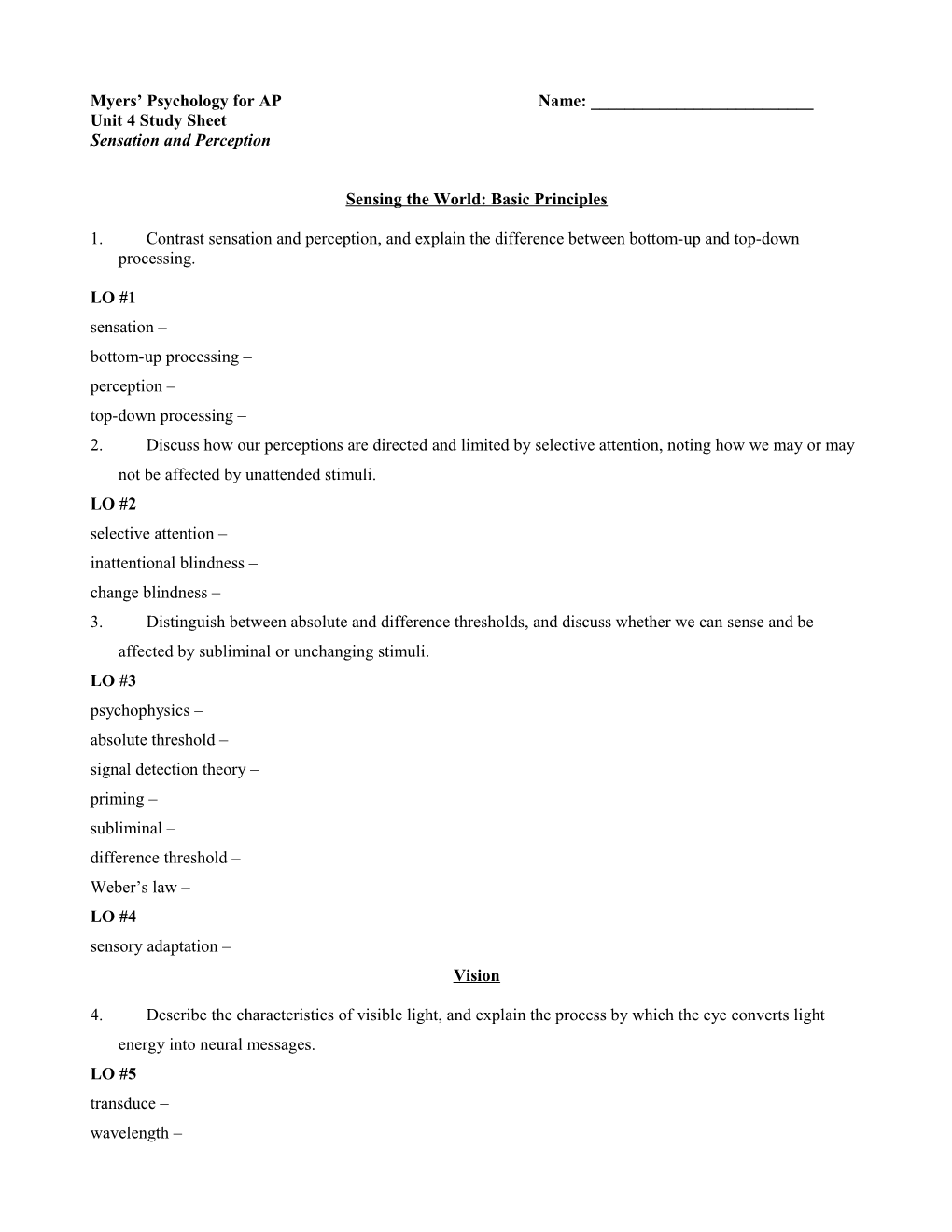Myers’ Psychology for APName: ______
Unit 4 Study Sheet
Sensation and Perception
Sensing the World: Basic Principles
1.Contrast sensation and perception, and explain the difference between bottom-up and top-down processing.
LO #1
sensation –
bottom-up processing –
perception –
top-down processing –
- Discuss how our perceptions are directed and limited by selective attention, noting how we may or may not be affected by unattended stimuli.
LO #2
selective attention –
inattentional blindness –
change blindness –
- Distinguish between absolute and difference thresholds, and discuss whether we can sense and be affected by subliminal or unchanging stimuli.
LO #3
psychophysics –
absolute threshold –
signal detection theory –
priming –
subliminal –
difference threshold –
Weber’s law –
LO #4
sensory adaptation –
Vision
- Describe the characteristics of visible light, and explain the process by which the eye converts light energy into neural messages.
LO #5
transduce –
wavelength –
hue –
intensity –
LO #6
pupil –
iris –
lens –
retina –
accommodation –
rods –
cones –
optic nerve –
blind spot –
fovea –
- Discuss the different levels of processing that occur as information travels from the retina to the brain’s cortex.
LO #7
feature detector –
- Define parallel processing and discuss its role in visual information processing
parallel processing –
- Explain how the Young-Helmholtz and opponent-process theories help us understand color vision.
LO #8
Young-Helmholtz trichromatic (three-color) theory –
opponent-process theory –
Hearing
- Describe the auditory process, including the stimulus input and the structure and function of the ear
audition –
LO #9
frequency –
pitch –
LO #10
middle ear –
cochlea –
inner ear –
- Contrast place and frequency theories, and explain how they help us to understand pitch perception.
LO #11
place theory –
frequency theory –
LO #12
- Describe how we pinpoint sounds, and contrast the two types of hearing loss.
LO #13
conductive hearing loss –
sensorineural hearing loss –
- Describe how cochlear implants function, and explain why Deaf culture advocates object to these devices.
cochlear implant –
- Describe the senses of touch, and distinguish between kinesthesis and the vestibular sense.
LO #14
kinesthesis –
vestibular sense –
- State the purpose of pain, and describe the biopsychosocial approach to pain.
gate-control theory –
- Describe the senses of taste and smell, and comment on the nature of sensory interaction.
LO #15
sensory interaction –
LO #16
Perceptual Organization
- Describe Gestalt psychology’s contribution to our understanding of perception, and identify principles of perceptual grouping in form perception.
LO #17
gestalt –
LO #18
figure-ground –
grouping –
- Explain the binocular and monocular cues we use to perceive depth.
LO #19
depth perception –
visual cliff –
binocular cues –
retinal disparity –
monocular cues –
- State the basic assumptions we make in our perception of motion, and explain how these perceptions can be deceiving.
LO #20
phi phenomenon –
- Explain how perceptual constancies help us to organize our sensations into meaningful perceptions.
LO #21
perceptual constancy –
Perceptual Interpretation
- Describe the contributions of restored vision, sensory deprivation, and perceptual adaptation research to our understanding of the nature-nurture interplay in our perception.
LO #22
LO #23
perceptual adaptation –
- Define perceptual set, and explain why the same stimulus can evoke different perceptions in different contexts.
LO #24
perceptual set –
Is There Extrasensory Perception?
- Identify the three most testable forms of ESP, and explain why most research psychologists remain skeptical of ESP claims.
LO #25
extrasensory perception (ESP) –
parapsychology –
